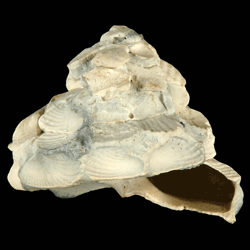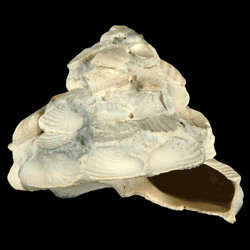
Xenophoridae

- Phylum: Mollusca
- Class: Gastropoda
- Order: Littorinimorpha
- Family: Xenophoridae
Overview
Common name: Carrier shells
Key morphological features: The Xenophoridae are medium sized gastropods with thin, trochiform or conical shells. The body whorl is flared at the base, extending beyond the suture in earlier whorls, and the aperture is oblique, producing a flat or concave anterior/ventral surface of the shell. The most striking feature of the Xenophoridae, and the origin of their common name, is the debris (other shells, stones, etc.) that the animal cements to the shell as it grows. Sources: Davies, A.M. 1971. Tertiary Faunas Vol. 1, second edition. New York: American Elsevier Publishing Company, Inc. 571 pp.; Tunnell Jr., J.W., Andrews, J., Barrera, N.C., Moretzsohn, F. 2010. Encyclopedia of Texas Seashells. College Station: Texas A&M University Press. 512 pp.
Geological range: Cretaceous to Recent (Davies, 1971).
Geographic distribution: A distributional map for modern Xenophoridae may be accessed from OBIS. A distributional map for ancient Xenophoridae may be accessed from the Paleobiology Database.
Diversity: There are 25 recognized living species of Xenophoridae and 3 genera (WoRMS database, unvetted). The Paleobiology Database recognizes 5 fossil genera and 70 fossil species of Xenophoridae (unvetted).
Paleoecology: The Xenophoridae are herbivorous and detritivorous marine gastropods. They live in soft substrates including muds, silts, and sands in both shallow and deep warm waters worldwide. The reason for the peculiar ornamentation that Xenophorids attach to themselves is not known, but some authors believe it could serve as camouflage or may help to stabilize the shell in soft sediments. Source: Tunnell et al. (2010); Simone, L.R.L. 2005. Comparative morphological study of representatives of the three families of Stromboidea and the Xenophoroidea (Mollusca, Caenogastropoda), with an assessment of their phylogeny. Arquivos de Zoologia, Museu de Zoologia da Universidade de São Paulo 37 (2): 141-267.
Phylogenetic status: Monophyletic. The morphological phylogenetic analysis by Simone (2005) supports the monophyly of Family Xenophoridae. Reference: Simone, L.R.L. 2005. Comparative morphological study of representatives of the three families of Stromboidea and the Xenophoroidea (Mollusca, Caenogastropoda), with an assessment of their phylogeny. Arquivos de Zoologia, Museu de Zoologia da Universidade de São Paulo 37 (2): 141-267.
